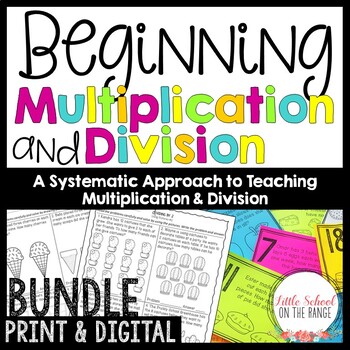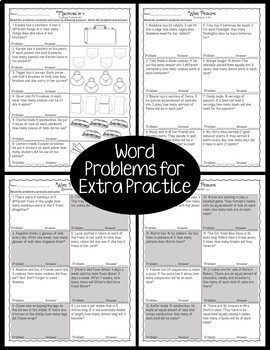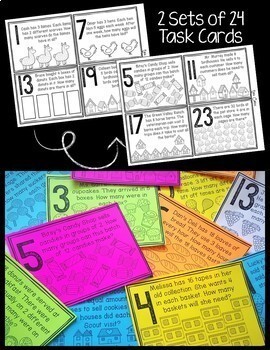Beginning Multiplication and Division BUNDLE | Print and Digital
- Zip
- Google Apps™

What educators are saying
Products in this Bundle (4)
Description
Looking for a great way to introduce multiplication and division? This bundle is ideal for use distance learning as it allows students to work independently and also has a link for Google Classroom.
NOTE: This resource now has Google Classroom activities, making it ideal for digital distance learning and remote teaching! Please see the 3rd page of each PDF for the links!
Units contained in this bundle:
Beginning Multiplication: Completely revised for the new school year!!! This unit is perfect for introducing your students to multiplication. It begins with allowing students to draw pictures and then move on to word problems. Practice is given for multiplying by 2,3,4, and 5. This can be used in the regular education classroom or special education classroom. It can be used for extra practice, RTI, or differentiated instruction. This unit includes:
• 3 Pages for Drawing Pictures for Multiplying by 2
• 3 Pages for Drawing Pictures for Multiplying by 3
• 3 Pages for Drawing Pictures for Multiplying by 4
• 3 Pages for Drawing Pictures for Multiplying by 5
• 3 Pages for Drawing Pictures for Multiplying by 2,3,4,5
• Drawing Pictures for Multiplication Assessment
• 2 Pages for Multiplying by 2
• 2 Pages for Multiplying by 3
• 2 Pages for Multiplying by 4
• 2 Pages for Multiplying by 5
• 2 Pages for Multiplying by 2,3,4,5
• Word Problems for Multiplication Assessment
• Set of 24 Task Cards
• Suggestions for Implementing Unit and Using Task Cards
• Answer Key
Beginning Division: Completely revised for the new school year!!! This unit is perfect for introducing your students to division! It begins with allowing students to draw pictures and then move on to word problems. Practice is given for dividing by 2,3,4, and 5. This can be used in the regular education classroom or special education classroom. It can be used for extra practice, RTI, or differentiated instruction. This unit includes:
• Using Counters to Divide by 2
• Dividing by 2 Using Pictures – 2 Pages
• Word Problems for Dividing by 2 – 2 Pages
• Using Counters to Divide by 3
• Dividing by 3 Using Pictures – 2 Pages
• Word Problems for Dividing by 3 – 2 Pages
• Using Counters to Divide by 4
• Dividing by 4 Using Pictures – 2 Pages
• Word Problems for Dividing by 4 – 2 Pages
• Using Counters to Divide by 5
• Dividing by 5 Using Pictures – 2 Pages
• Word Problems for Dividing by 5 – 2 Pages
• Using Counters to Divide by 2,3,4, & 5
• Dividing by 2,3,4,& 5 Using Pictures – 2 Pages
• Word Problems for Dividing by 2,3,4,& 5 – 2 Pages
• Word Problems Assessment – 2 Pages
• Set of 24 Task Cards with Answer Sheet
• Suggestions for Using this Unit
• Answer Key
Not sure if this is for you? Download the PREVIEW for a free sample!





